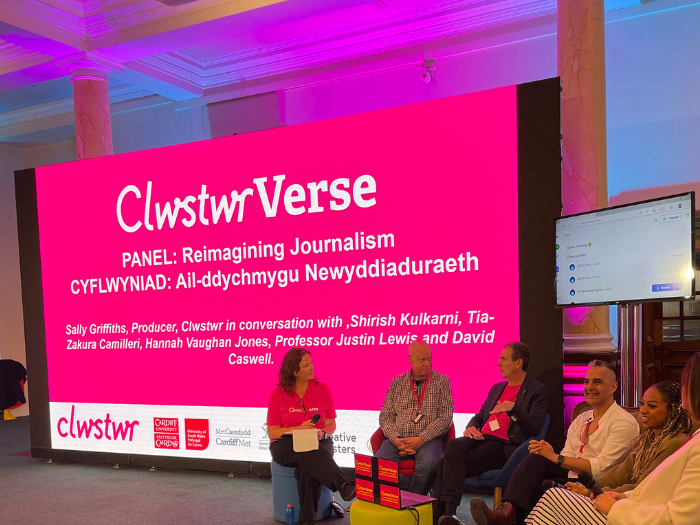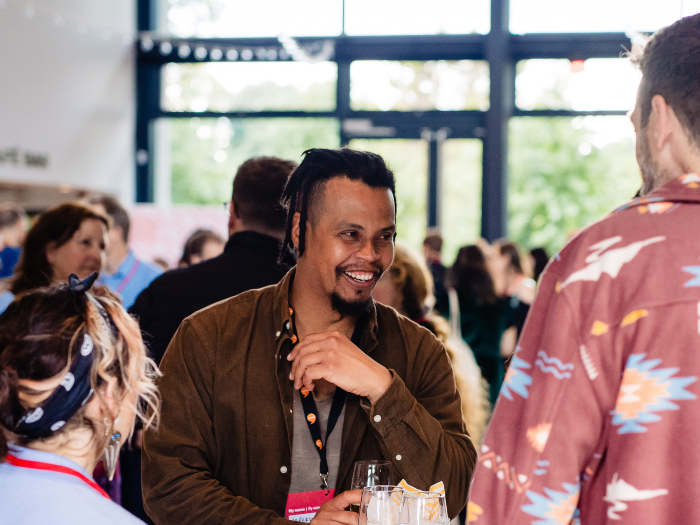From ideas to policy: a brief history of the creative economy
16 April 2024
The idea of ‘the culture industry’ was developed more than 70 years ago (Adorno and Horkheimer, 1947), at a time when many popular cultural forms were still emerging, and when cultural arbiters from various political perspectives saw a clear distinction between art and commerce. Cultural value was seen as a counterpart to, rather than a part of, popular taste. This distinction was quickly embedded in public policy in the UK and elsewhere, whether through Reithian models of public service broadcasting or public funding of the arts (Lewis, 1990).
By the 1960s, the simultaneous growth of popular culture and the social sciences made this rarefied notion of culture untenable. From the 1960s to the 1980s, a number of cultural theorists (such as Raymond Williams, Stuart Hall, Richard Hoggart and Pierre Bourdieu) began to question traditional cultural value systems that valued ‘high’ culture and ignored popular culture. They argued for a much broader, more inclusive notion of culture and creativity, one that was rooted in most people’s everyday lived experience.
This laid the ground for the beginnings of a policy shift. In the 1980s, the Greater London Council (GLC) alongside the Great London Enterprise Board (GLEB) began to imagine what a broader, more democratic cultural policy might look like, moving away from the more exclusive idea of ‘the arts’ towards the broader notion of ‘the creative industries’ (Mulgan and Worpole, 1986). Policy interventions were no longer about simply protecting ‘the arts’ but having positive impacts across a much broader cultural space.
On the other side of the world, Paul Keating’s Australian Government picked up the creative industries theme. The Creative Nation report, published in 1994, made a decisive move away from traditional arts policy towards a more inclusive approach that included film and television, while reframing the Australian creative industries in economic as well as cultural terms (Hawkins, 2014).
This set the stage, in 1997, for the UK Labour Government to embrace a creative industries approach. They replaced the Department of National Heritage (1992-97) with the Department of Culture, Media and Sport (DCMS), which became emblematic of the new economic landscape of innovation and creativity, technology and globalised media industries (Hesmondhalgh, Oakley, Lee and Nisbett, 2015). This was the age of ‘Cool Britannia’, when the creative industries were seen as shaping and defining British culture and identity while boosting the UK economy.
John Howkins’ (2001) book on the Creative Economy and Richard Florida’s (2002) essay on the importance of ‘the creative class’ – as a driver of innovation and economic growth in a digital world – placed the creative industries, and creative occupations more generally, at the heart of 21st century economies. They argued that creativity was a key driver of prosperity in a world where assets are increasingly bound up with intellectual rather than physical property – in ideas rather than objects (the ‘intangible economy’). The creative industries were not only growing faster than other sectors, they were central to the development of the economy as a whole, incorporating creative workers – such as designers and content creators – in most industrial sectors.
The identification – and celebration – of the creative economy coincided with the decline of manufacturing across the developed world. Urban areas keen to regenerate – both through a start-up culture and attracting inward investment – embraced the idea of the ‘creative city’. Creative cities not only sparked innovation and economic growth (Potts and Cunningham, 2008, p.10), they were seen as more dynamic and more attractive places to live.
In 2013 Nesta published their Manifesto for the creative economy, making a powerful case for putting the cultural and creative at the heart of government policy. In the same year, the UK government, through the DCMS, developed a methodology for identifying creative sectors to capture and measure their economic impact – – marking a moment when, for the first time, ‘the creative industries’ came into being as an identifiable
The size, scale and growth trajectory of the cultural and creative industries was now a demonstrably significant part of the UK (and global) economy. In 2017 the UK Government commissioned an Independent Review of the Creative Industries which put the creative industries at the heart of the UK’s rapidly growing digital economy. One of its strongest recommendations was to support regional creative industries clusters across the UK.
The Government responded by funding the £80m Creative Industries Clusters Programme (CICP), which supported (through the Arts and Humanities Research Council) the establishment of nine creative industry clusters across the UK – one of which – Clwstwr – was led by the Centre for the Creative Economy. The success of the CICP programme (Lewis et al, 2023) paved the way for further investment by governments – led by different political parties – across the four nations of the UK. In 2022, the EU, through the European Institute of Innovation and Technology (EIT), made their first multi million Euro investment in a culture and creativity Knowledge and Innovation Community (KIC).
The rise of the creative economy has brought with it a growing body of critical scrutiny. So, for example, Philip Schlesinger (2017) argues that while the notion of the creative economy has been important politically, it comes at a price: a policy realm where culture is secondary, invariably trumped by the logic of economics. Justin O’Connor (2023) develops this critique, arguing strongly for a reassertion of cultural and social values in the creative process.
The uncritical embrace of the ‘creative class’ as a positive force in equitable economic regeneration has also been questioned (Pratt, 2008; Haskel and Westlake, 2017). The creative industries have, in many ways, defined the rise of the precarious ‘gig economy’, accompanied by a series of employment practices (word of mouth, low pay and long hours at entry level) that limit both access to employment and job security.
This leaves us at an interesting moment. Prodigious growth alongside a number of research-led policy initiatives have made the creative economy a compelling proposition for policymakers, while its form and structure have become increasingly subject to critical examination. The Centre for the Creative Economy at Cardiff University is a space where critical scrutiny informs policy development, with an understanding of the creative economy that takes account of its history and its complexities. Its size and significance matters, but so does its ability to work for the people it employs, for its audiences and for our broader cultural environment. Our goal is to inform policy initiatives that deliver social, cultural and economic value.

Our mission: towards a green, fair creative economy
We adopt the DCMS’s definition of the creative economy, which includes those employed in the creative industries as well as people in creative occupations in other sectors (embedded creatives in other sectors, like designers or content creators). So while the creative industries are a focal point, they are a subset of a larger creative economy, in a world where communication and creative content are ubiquitous part of work and leisure.
We see the creative economy as a mixed economy. It includes sectors (like theatre and the visual arts) that receive subsidies in return for perceived cultural, social or economic benefits, as well as the more commercial cultural industries. This mixed economy is expressed by the term, Creative and Cultural Industries and Sectors (or CCSIs), now increasingly adopted across European creative clusters. This is a continuum rather than a simple binary: many arts organisations depend on public funding but still raise commercial revenue, while more commercial sectors, like film and TV production, receive government support through tax credits and other incentives.
Despite significant advances, the data picture of the creative economy remains incomplete, for two main reasons. First, because of its dependence on a large freelance workforce, who are excluded from most UK data sets. Second, while we have information about the scale of the creative industries (excluding freelancers), we know much less about the size and shape of the embedded creative workforce. The Centre has developed analysis of existing data sets and created new data sets to develop our understanding of the size and shape of the CCSIs. So, for example, we publish an interactive Creative Economy Atlas of the CCSIs across Wales, the most comprehensive of its kind in the UK.
What we do know is that the economic importance of the creative industries in the UK is substantial and growing. One in eight UK businesses are part of the creative industries, and together they contributed almost £116 billion in GVA in 2019, growing four times faster than the rate of the UK economy as a whole (DCMS, 2021). In 2018, UNESCO predicted that the creative and cultural industries could be worth up to 10% of global GDP in the coming years, with the UK one of the world’s biggest exporters of creative products and services (The Economist Intelligence Unit, 2021). The creative industries have become increasingly important to the Welsh economy, particularly in the Cardiff Capital Region (Komorowski, Fodor and Lewis, 2021), making it a priority sector for regional economic development.
Across this cultural continuum, the creative industries play a pivotal role in people’s lives. They can provide pleasure and meaning, and they tell the stories that shape our cultural environment. But the creative industries provide jobs, tax revenues and spill over into almost every other industrial sector. Both these things matter: any cultural strategy must be underpinned by economic conditions that make it possible.
This also means addressing the many ways in which economic policies shape – or constrain – cultural and creative outcomes. If we want a more inclusive and greener creative economy – one that celebrates a diversity of voices, limits environmental damage and generates a strong local tax base for funding public services – we need to develop strategies and systems able to deliver them.
The Centre for the Creative Economy uses multi-disciplinary, engaged research to analyse, interrogate, test and expand our understanding of the value of creativity to both the human spirit and the bottom line. Our work flows from a myriad of co-productions with hundreds of creative industry partners in Wales and around the world. It focuses on how collaboration, innovation and research enable creativity to thrive in a fairer, greener, more prosperous creative economy.
Much of our work is place-based, building and exploring the dynamics of regional creative clusters. One of the Centre’s longest running initiatives was to create and inform Creative Cardiff, a network with more than 4000 touchpoints with creative organisations and freelancers across the Cardiff region. Creative Cardiff’s research and engagement supports the equitable development of the creative clusters in Wales (e.g. Komorowski and Lewis, 2021, on the impact of Brexit on the Welsh creative industries), and beyond, analysing the value of networks and creative spaces across the UK (Komorowski, Lupu, Lewis and Pepper, 2021) and internationally (Komorowski, Fodor, Lewis and Pepper, 2023).

The establishment of Creative Cardiff provided a platform for a number of other place-based interventions, notably Clwstwr – a £10 million programme, supported by the AHRC and Welsh Government, which built innovation in Welsh CCSIs by curating 120 research and development (R&D) projects with industry partners – and Media Cymru, a £50 million 22-partner research, development and innovation (RD&I) Consortium supporting fair, green, global growth in the Welsh media and screen sectors.
These initiatives have spawned research into regional creative clusters, developing new models for research, development and innovation, promoting equality, diversity and inclusion and environmental sustainability for the CCSIs (see, for example, Komorowski ,Fodor, and Lewis, 2021; Lewis et al, 2023; Lupu et al, 2023; Komorowski and Lewis, 2023).
This research seeks to move beyond divisions between cultural and economic value, or between financial and social goals. The question, for us, is simple: to understand how creative economies can work most effectively to produce positive and sustainable outcomes.
Professor Justin Lewis is the Co-Director of the Centre for the Creative Economy at Cardiff University. He is a professor of Communication and Creative Industries at the Cardiff School of Journalism, Media and Culture, and Director of Clwstwr and Media Cymru.
References
Theodor Adorno and Max Horkheimer (1947)‘The Culture Industry’ in Dialectic of Enlightenment, translated by E. Jephcott. Stanford: Stanford University Press.
Hasan Bakshi, Ian Hargreaves and Juan Marteos-Garcia (2103) A Manifesto for the Creative Economy, Nesta.
Peter Bazalgette (2017) Independent Review of the Creative Industries, UK Govt, https://www.gov.uk/government/publications/independent-review-of-the-creative-industries
Walter Benjamin (1935) ‘The Work of Art in the Age of Mechanical Reproduction’
Claudia Berger, Eliza Easton and Hasan Bakhshi (2021) Creative Places: Growing the creative economy across the UK, Creative Industries Policy and Evidence Centre, https://creative-pec.files.svdcdn.com/production/assets/publications/Creative-Places-PEC-Policy-Briefing-July-2021.pdf
Pierre Bourdieu (1984) Distinction: A Social Critique of the Judgement of Taste, Routledge
The Economist Intelligence Unit (2021) Creative industries: trade challenges and opportunities post pandemic, https://impact.economist.com/perspectives/sites/default/files/eiu_dit_creative_industries_2021.pdf
Richard Florida (2002) The Rise of the Creative Class: And How It’s Transforming Work, Leisure, Community and Everyday Life, New York: Basic Books.
Rosalind Gill, Andy Pratt and Tarek Virani (eds) (2019) Creative Hubs In Question: Place, space and work in the creative economy, Palgrave Macmillan
Jonathan Haskel and Stian Westlake (2017), Capitalism Without Capital: The Rise of the Intangible Economy, Princeton University Press.
Rebecca Hawkins (2014) Paul Keating’s Creative Nation: a policy document that changed us, The Conversation, https://theconversation.com/paul-keatings-creative-nation-a-policy-document-that-changed-us-33537
David Hesmondhalgh, Kate Oakley, David Lee and Melissa Nisbett (2015). Culture, Economy and Politics: The Case of New Labour, Palgrave Macmillan.
Marlen Komorowski, Mate Fodor, Justin Lewis (2021). Clwstwr Creative Industries Report No. 2: The media sector in the Cardiff Capital Region. Project Report. [Online]. Clwstwr. Available at: https://clwstwr.org.uk/clwstwr-creative-industries-report-no-2-media-sector-cardiff-capital-region-driving-economic-growth
Marlen Komorowski, Mate Fodor, Justin Lewis and Sara Pepper (2023) Creative hubs and intercultural dialogue—towards a new socio-economic narrative. Sustainability 15(10), article number: 8282. (10.3390/su15108282)
Marlen Komorowski and Justin Lewis (2021) Ckwstwr Policy Brief No 1: The (potential) impact of Brexit on creative businesses. Implications for policy and businesses in Wales. Cardiff: Available at: https://clwstwr.org.uk/sites/default/files/2020-07/Clwstwr%20Policy%20Brief%20No%201_FINAL.pdf
Marlen Komorowski and Justin Lewis (2023) The creative and cultural industries: towards sustainability and recovery. Sustainability 15(13), article number: 9923. (10.3390/su15139923)
Marlen Komorowski, Ruxandra Lupu, Justin Lewis and Sara Pepper (2021) Joining the dots—understanding the value generation of creative networks for sustainability in local creative ecosystems. Sustainability 13(22), article number: 12352. (10.3390/su132212352)
Justin Lewis, (1990) Art, Culture and Enterprise, Routledge.
Justin Lewis, Marlen Komorowski, Mate Fodor, Ruxandra Lupu, Sara Pepper, Lee Walters and Kayleigh McLeod (2103) Clwstwr, A model for research, development and innovation in the creative industries, The Centre for the Creative Economy
Lupu, R., Komorowski, M., Lewis, J., Mothersdale, G. and Pepper, S. (2023) Greening the audiovisual sector: towards a new understanding through innovation practices in Wales and beyond. Sustainability 15(4), article number: 2975. (10.3390/su15042975)
Geoff Mulgan and Ken Worpole, Saturday night and Sunday morning, Comedia, 1986.
Justin O’Connor (2023) Culture is not an industry: reclaiming art and culture for the common good, Manchester University Press.
Jason Potts and Stuart Cunningham (2008). “Four Models of the Creative Industries,” International Journal of Cultural Policy 14(3): 233‐247.
Andy Pratt (2008) Creative cities: the cultural industries and the creative class. Geografiska Annaler, Series B: Human Geography, 90 (2). pp. 107-117. ISSN 0435-3684
Philip Schlesinger (2017) ‘The creative economy invention of a global orthodoxy in Innovation’, The European Journal of Social Science Research 1:30.
